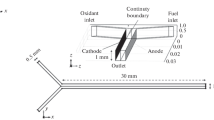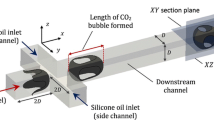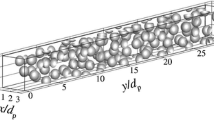Abstract
By means of microfluidic analysis with a thermal lattice-Boltzmann method, we investigated the hydrophilic, thermal and geometric effects on the dynamics of CO2 bubbles at anode microchannels (e.g., porous layers and flow channels) of a micro-direct methanol fuel cell. The simulation results show that a more hydrophilic wall provides an additional attractive force to the aqueous methanol in the flow direction and that moves the CO2 bubble more easily. The bubble propagates quicker in the microchannel with a positive temperature gradient imposed from the inlet to the exit, mainly due to the Marangoni effect. Regarding the geometric effect of the microchannel, the bubble moves more rapidly in a divergent microchannel than in a straight or convergent channel. On the basis of the quantitative evaluation of hydrophilic, thermal and geometric effects, we are able to design the bubble-removal technique in micro fuel cells.













Similar content being viewed by others
Abbreviations
- e :
-
lattice velocity vector
- e :
-
lattice speed (cm/s)
- f :
-
density distribution function (g/cm3)
- g :
-
thermal distribution function (g K/cm3)
- \(G^{{\sigma \sigma^{\prime}}}\) :
-
interaction strength between the species σ and the other species σ′ (cm3/g s)
- G σ :
-
fluid–solid interaction potential parameter of the species σ
- G :
-
gravitational constant (cm/s2)
- G′:
-
non-dimensional constant
- T :
-
temperature (K)
- t :
-
time (s)
- U :
-
velocity vector(u,v)
- u :
-
velocity in the x-direction (cm/s)
- v :
-
velocity in the y-direction (cm/s)
- X :
-
position vector (x,y)
- β:
-
thermal expansion coefficient (1/K)
- ρ:
-
density (g/cm3)
- θ:
-
contact angle (°)
- τ:
-
collision time for momentum transfer
- τ T :
-
collision time for energy transfer
- ψ:
-
function of the mass density
- i :
-
lattice velocity directions
- ∞:
-
reference state
- eq:
-
equilibrium
- σ:
-
species
References
Fei K, Hong CW (2007) All-angle removal of CO2 bubbles from the anode microchannels of a micro fuel cell by lattice-Boltzmann simulation. Microfluid Nanofluid 3:77–88
Fei K, Cheng CH, Hong CW (2006) Lattice Boltzmann simulations of CO2 bubble dynamics at the anode of a μDMFC. Trans ASME J Fuel Cell Sci Tech 3:180–187
Guo Z, Zheng C, Shi B, Zhao TS (2007) Thermal lattice Boltzmann equation for low Mach number flows: decoupling model. Phys Rev E 75:036704-1-036704-15
Inamuro T, Yoshino M, Inoue H, Mizuno R, Ogino F (2002) A lattice Boltzmann method for a binary miscible fluid mixture and its application to a heat-transfer problem. J Comput Phys 179:201–215
Jun TK, Kim CJ (1998) Valveless pumping using traversing vapor bubbles in microchannels. J Appl Phys 83:5658–5664
Lu GQ, Wang CY (2004) Electrochemical and flow characterization of a direct methanol fuel cell. J Power Sources 134:33–40
Shan X (1997) Simulation of Rayleigh–Bénard convection using a lattice Boltzmann method. Phys Rev E 55:2780–2788
Shan X, Chen H (1993) Lattice Boltzmann model for simulating flows with multiple phases and components. Phys Rev E 47:1815–1819
Shan X, Chen H (1994) Simulation of nonideal gases and liquid–gas phase transitions by the lattice Boltzmann equation. Phys Rev E 49:2941–2948
Shi Y, Zhao TS, Guo ZL (2004) Thermal lattice Bhatnagar–Gross–Krook model for flows with viscous heat dissipation in the impressible limit. Phys Rev E 70:066310-1–066310-10
Takahashi K, Weng JG, Tien CL (1999) Marangoni effect in microbubble systems. Microscale Therm Eng 3:169–182
Takahashi K, Yoshino K, Hatano S, Nagayama K, Asano T (2001) Novel applications of thermally controlled microbubble driving system. Proceedings of the IEEE Micro Electro Mechanical Systems (MEMS) 286–298
Wong CW, Zhao TS, Ye Q, Liu JG (2005) Transient capillary blocking in the flow field of a micro-DMFC and its effect on cell performance. J Electrochem Soc 152:A1600–A1605
Yang H, Zhao TS, Ye Q (2005) In situ visualization study of CO2 gas bubble behavior in DMFC anode flow fields. J Power Sources 139:79–90
Young T (1805) An essay on the cohesion of fluids. Phil Trans R Soc 95:65–87
Young NO, Goldstein JS, Block MJ (1959) The motion of bubbles in a vertical temperature gradient. J Fluid Mech 6:350–356
Yuan P, Schaefer L (2006a) A thermal lattice Boltzmann two-phase flow model and its application to heat transfer problems-Part 1. Theoretical foundation. Trans ASME J Fluids Eng 128:142–150
Yuan P, Schaefer L (2006b) A thermal lattice Boltzmann two-phase flow model and its application to heat transfer problems-Part 2. Integration and validation. Trans ASME J Fluids Eng 128:151–156
Acknowledgments
National Science Council (contract NSC 95-2218-E-007-001) provided financial support; National Center for High-performance Computing provided high-speed computer facilities.
Author information
Authors and Affiliations
Corresponding author
Rights and permissions
About this article
Cite this article
Fei, K., Chen, W.H. & Hong, C.W. Microfluidic analysis of CO2 bubble dynamics using thermal lattice-Boltzmann method. Microfluid Nanofluid 5, 119–129 (2008). https://doi.org/10.1007/s10404-007-0232-x
Received:
Accepted:
Published:
Issue Date:
DOI: https://doi.org/10.1007/s10404-007-0232-x




